 The exchange that begins below resulted from ongoing efforts by myself, J. Ross Baughman, and others to disentangle the web of misinformation and disinformation that has cocooned Robert Capa’s actions on Omaha Beach on June 6, 1944 and thereafter, along with the D-Day negatives he exposed and their subsequent fate.
The exchange that begins below resulted from ongoing efforts by myself, J. Ross Baughman, and others to disentangle the web of misinformation and disinformation that has cocooned Robert Capa’s actions on Omaha Beach on June 6, 1944 and thereafter, along with the D-Day negatives he exposed and their subsequent fate.
When former LIFE picture editor John G. Morris complained about this inquiry, I posed a set of questions to him. He agreed to answer them. I present those questions here as emailed to him, followed in each case by his emailed response. I’ve added a few bracketed notes for clarification. If the evidence contradicts what Morris asserts, I so indicate, again in brackets.
•
Morris prefaced his answers with these comments:
Dear A. D. Coleman,
This is to acknowledge your long series of blog attacks on me as LIFE‘s London picture editor in 1944, and on Robert Capa’s coverage of the D-Day landing on Omaha Beach on June 6, 1944. For example, from your post of June 23: “The myth of melted negatives in the London darkroom was concocted on the spot by John Morris, to hide Capa’s abject failure to deliver the goods when the chips were down.”
[As the following exchange makes clear, the saga of the melted negatives began in the LIFE darkroom on the night of June 7, 1944. And no one but Morris could have passed it along to Capa. Capa then published it in his 1947 memoir, Slightly Out of Focus. It became an integral element of Morris’s account of that evening’s mishaps, retold endlessly over the next seven decades. So he surely must take some responsibility for promulgating it relentlessly, thereby embedding it in the medium’s history and, more broadly in our cultural history. Did that come about innocently, as a result of his lack of technical grounding? I think each reader has to decide this.]
Although I cannot believe that your accusations will be taken seriously, you do deserve answers, I deserve an apology.
If I am slow to reply it is first of all because I have never undergone an attack such as yours in my 70-plus years as a picture editor. I did not have time to read what you wrote until after my return from an exhausting trip to New York and Toronto.
It all seems to have started when Ross Baughman, a distinguished photojournalist, correctly questioned the authenticity of the TIME video’s clumsy and, as a result, misleading reconstruction of Capa’s D-Day film, and its lack of credits.
[Baughman’s critique, which began this series of posts, doesn’t actually question the TIME video’s “misleading reconstruction of Capa’s D-Day film, and its lack of credits.” Instead, the noted photojournalist challenges the standard account of Capa’s time on Omaha Beach, as propounded by Capa and Morris, and questions Capa’s professionalism on that day.]
You incorrectly criticized me for having approved it. When TIME interviewed me about what happened the night of June 7, 1944 in LIFE‘s London darkroom, I told my usual story. So in fact I only gave them my voice. I did not see the TIME video until after I returned to Paris on July 2 and after I began to read your blog.
[That video’s soundtrack consists entirely of Morris’s narrative, which, along with his name, his reputation, and his status as the only surviving witness to the events described, de facto puts his imprimatur on the video, thus authenticating it. I assumed — reasonably, if incorrectly — that Morris had viewed and approved the components and the final version. By his account, he had no foreknowledge of, no say over, and no subsequent awareness of the decision by Adrian Keltenborn of Magnum in Motion and Cynthia Young of the Capa Archives to insert falsified examples of Capa’s “ruined” D-Day negatives into the video. If so, I apologize to Morris for asserting that he actively collaborated with them in this breach of journalistic ethics, of which I’m sure he disapproves, though he has yet to come right out and say so.]
I have told the story of that night in London countless times. I repeated precisely what Dennis Banks told me right after developing the film, that too much heat had ruined three of the four rolls of Capa’s 35mm “action” negatives. I rushed down to the darkroom and held those rolls in my own hands. Nothing on them! But on the fourth roll there were eleven frames worth printing. As with any picture editor, my job was to find the good images and not really to worry about the bad or non-existent ones. I then had to cut up the contact sheet and separate the negatives, placing them in glassine envelopes for censorship.
I suffered for years under the impression that I was responsible for that darkroom “disaster,” although I was a floor above the darkroom when it happened. It’s a great relief for me to realize, after all this time, that there may well never have been anything on those three rolls to begin with.
[If the recognition that Capa’s film came in blank alleviates a lingering sense of guilt over the presumed loss of any additional exposures from the U.S.S. Chase or Omaha Beach, that’s good.]
I gladly leave the question of whether the film actually melted to the experts. It is your unwarranted criticism of Capa that offends me the most. Too bad he can’t answer you from the grave.
Now for the 18 questions in your query of July 4:
ADC: Capa’s caption notes on his four rolls of 35mm film sent to you in London when he returned from Normandy indicate that he made three of those rolls aboard the U.S.S. Chase the night before the landing. He therefore exposed only a single roll on Omaha Beach, correct?
JGM: Capa sent captions only on the rolls he shot aboard the [U.S.S.] Chase, all Rollei [Rolleiflex, the 2-1/4″-format twin-lens reflex camera Capa also carried] as I recall. I don’t think he made any attempt to caption what he thought were the four rolls of “action.” He knew that that scene had been well described by radio and newspaper and wire service reporters.
[This avoids answering the question. But there were no “four rolls of ‘action,'” as Capa surely knew — and as Morris must have known once he read the caption notes. The caption notes — at least those published in the May 29, 2014 TIME video — specifically and exclusively discuss the three rolls of 36-exposure 35mm film made with his Contax cameras aboard the Chase the night before D-Day. The Rolleiflex uses 120 film, which gets only 12 exposures per roll, so there’s no confusing the 120 rolls with the 35mm rolls in those notes.]
ADC: The images on the first 3 rolls, made aboard the Chase during the crossing, would therefore have been little more than stock shots, as indicated in his caption notes: the troops resting, reading, playing cards and craps, socializing, the officers going over battle plans, etc. Correct?
JGM: The images made aboard the Chase were definitely secondary, as Capa well knew, but he shot them from a sense of journalistic responsibility, and captioned them.
ADC: Of the “salvaged” images on that fourth roll, the first shows the troops disembarking from the LCI on which Capa arrived at Omaha Beach. The next to last shows Pfc. Huston Riley, who recalls that immediately after helping to rescue him Capa ran for an outgoing LCI. In Slightly Out of Focus, Capa himself states that after he reached that LCI he made no more images of the battle. Thus the “magnificent eleven” constitute not just what you managed to “save” but the entirety of Capa’s take from Omaha Beach, correct?
JGM: It now seems that those eleven frames probably constitute the entirety of Capa’s Omaha Beach take — until he returned there to cover the ongoing combat. [Capa got back to Normandy late on June 7, by which time the battle on the beaches had ended and the fighting had moved inland.]
ADC: In that case, all claims of a total of 106 images of the landing, including Capa’s, are false. Correct?
JGM: I don’t remember ever claiming that he made 106 beach images. Is that Whelan?
[It’s Capa himself, in Slightly Out of Focus (1947). It’s also Richard Whelan, his authorized biographer; Cynthia Young, curator of the Capa Archives at the International Center of Photography; Marie Brenner in Vanity Fair — who bumps it up to 144 images — and virtually every other writer who’s stuck to the party line on this for the past 70 years. It’s also John Morris, as in this June 5, 2004 New York Times memoir, “D-Day/60Years Later”: “After shooting four rolls of film [on Omaha Beach], Capa ‘had it bad’ and made it back to England with a shipload of wounded.” And Morris again in this June 7, 2011 interview for France24 TV: “[The image of Pfc. Huston Riley] is perhaps the most memorable of the eleven frames that we saved from Robert Capa’s four rolls of film on the landing on Omaha Beach,” at timestamp 3:10.]
ADC: Thus Capa’s claim in Slightly Out of Focus that he used his second Contax to expose a second roll of film while on the beach is also false. Correct?
JGM: Unfortunately I can’t get to my copy of Slightly Our of Focus but Capa played loose with such facts in that book, by his own admission. He wanted to sell it to Hollywood. If Capa did indeed load his second Contax, in the chaos and confusion of the battle, is it not possible that he simply forgot to remove the lens cap?
[Seems unlikely that an experienced professional photographer would shoot an entire roll of film with the lens cap on, even under fire. But exposing a mere 11 negatives of the battle would surely make the book harder to sell to Hollywood. I hadn’t considered the possibility that Capa intended his memoir as a screenplay treatment; if true, that certainly explains a lot.]
ADC: Moreover, Capa claims in Slightly Out of Focus that while exposing that imaginary second roll in his second Contax “I didn’t dare to take my eyes off the finder of my Contax and frantically shot frame after frame.” But the Contax II doesn’t have an advance lever; you use a knurled advance knob to wind the film forward, which takes several seconds each time and can’t be done with one’s eye glued to the viewfinder. So Capa lied about this, correct?*
JGM: Ditto. [More exaggeration for Tinseltown?]
•
[* Note, July 14, 2015: I stand corrected on this. Photographers who have used the Contax II and other 35mm cameras with similar knurled advance knobs inform me that one learned to advance the film a frame at a time without moving the eye away from the finderby pressing the tip of one’s right forefinger or middle finger hard against the front of the knob and pulling quickly to the right. So Capa could in fact have “frantically shot frame after frame.” He simply didn’t. — A. D. C.]
•
(For an index of links to all posts in this series, click here.)
•
This post supported by a donation from Prof. Andrew Szegedy-Maszak, Dept. of Classical Studies, Wesleyan University.


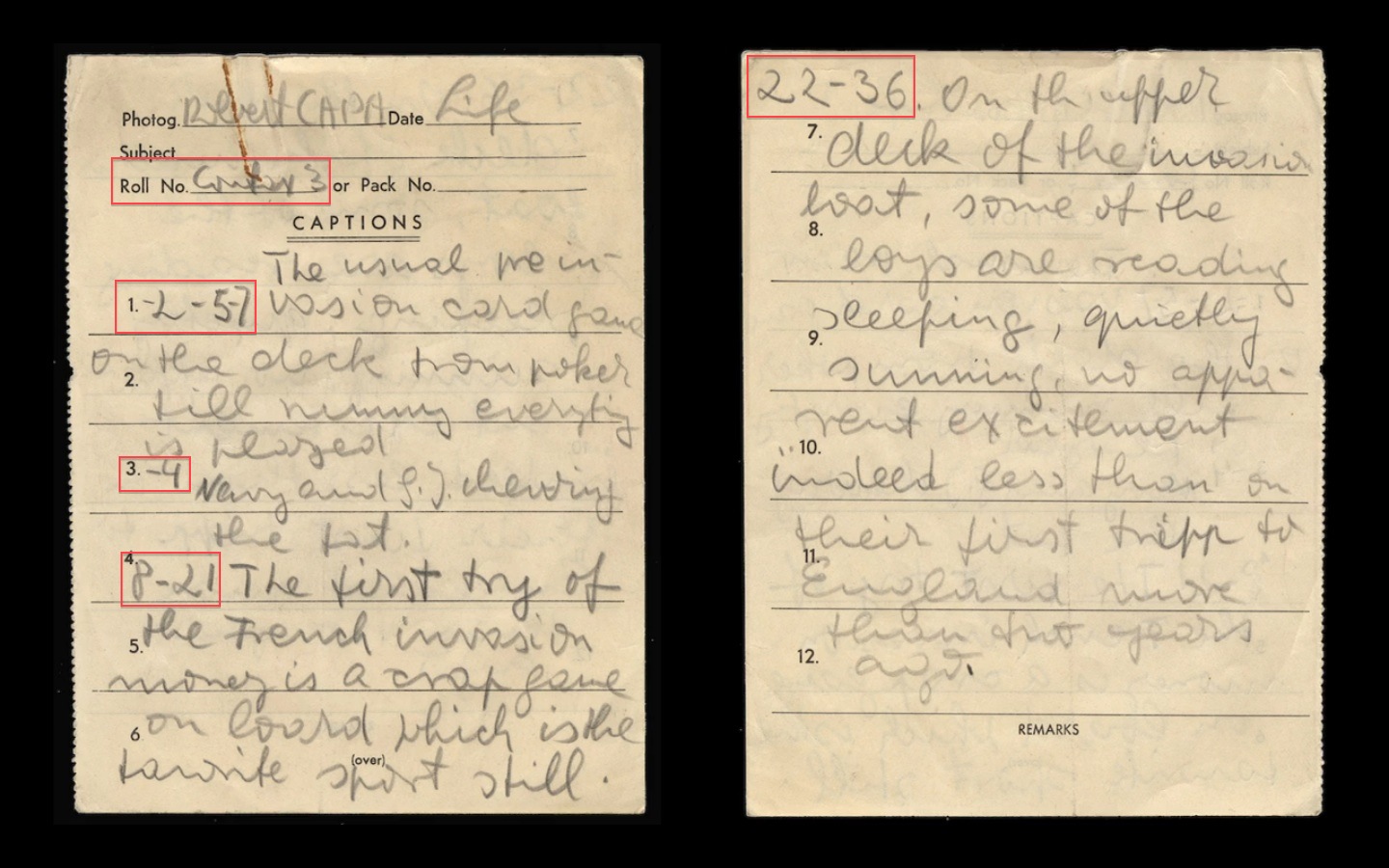
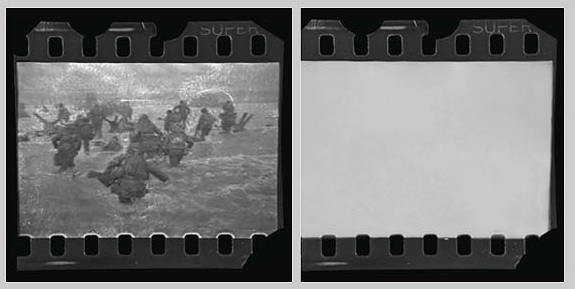
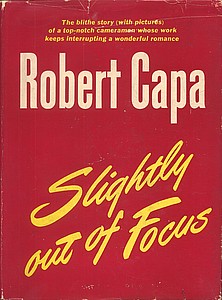
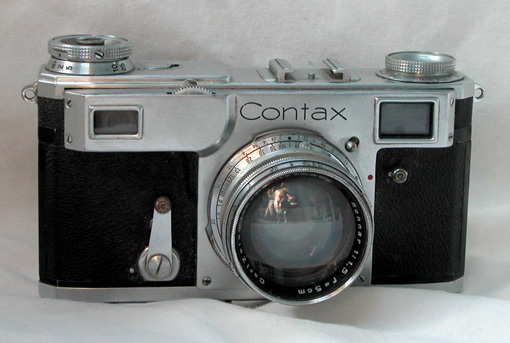
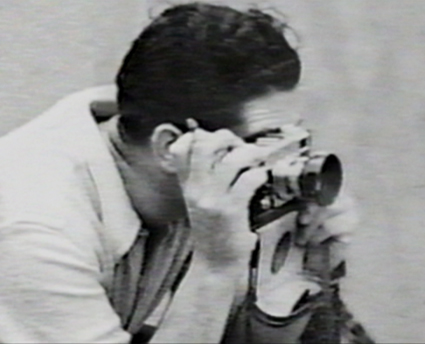




Allan,
As I said before, I have come to appreciate your sticking to this story. I believe both of us are of a mind to respect the desires of a nonagenarian to want to clear his name.
In reading this, two things stand out. One is his guilt over his belief that the rolls were destroyed. The second is the gap between his role as a participant and yours as a journalist/historian. He is certainly guilty of a casual attitude toward the truth which I see as understandable. I see people around me making this kind of mistake frequently. Human nature I suppose.
That allows me to be thankful for what you are doing without holding Morris culpable, just mistaken. There is a difference between being critical and being judgmental.
Best,
Chuck
Dear A. D.:
Thank you for the series of blog pieces about Robert Capa and the Omaha Beach pictures. I’ve read each of them with great interest as it came along, and looked forward to each following episode. I have especially enjoyed the way you and Ross Baughman have collected, quizzed and analysed the evidence. Fascinating. You have sent me off on tangents, such as reading technical stuff about the Contax shutter and its vulnerability to second-curtain-closure failure as a possible cause of fogged film — an idea that was shown to be a red herring when you demonstrated that the video images of spoiled film were (shamefully) faked.
My understanding of ‘the truth’ has developed through the series, through twists and turns.
I’ll end this fan mail with a small peeve. In today’s piece [‘Q&A with John Morris (a)’] you refer to Capa’s Rolleiflex as using ‘120mm’ film. I guess you think in inches, not millimetres, so you might not be aware how silly this sounds. Lots of Americans make the same mistake, so I shouldn’t be too hard on you. I grew up with inches and underwent a metric conversion in my twenties, so I am bicultural. When I read ‘120mm’ I’m able to translate to ‘a bit less than five inches’. I don’t know what a metric-thinker would make of it.
Please, call it ‘120’ film, or ‘6x6cm’ or ‘two-and-a-quarter-square’.
There, it was good to get that off my chest. I feel better now.
Cheers
Peter
Thanks for this. Speaking for all involved in this investigation, we’re pleased you’ve found it engaging and instructive.
I stand corrected (and abashed) re “120mm” film. The fault is mine. I actually know it’s not 120mm (though, as a Murcan, I’m not a “metric thinker”); I’ve referred to it as 120 in previous posts. That just slipped in there somehow, probably because I’m so carefully adding mm to 35, and I didn’t spot it while proofreading. I’ve corrected it. Now we both feel better.